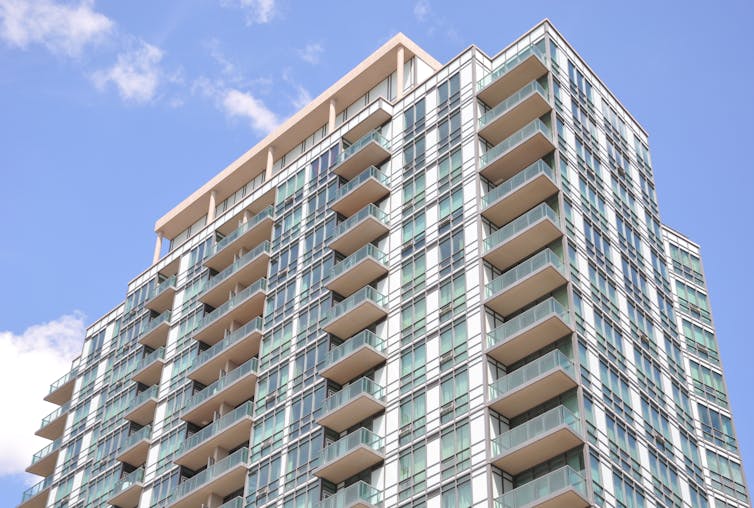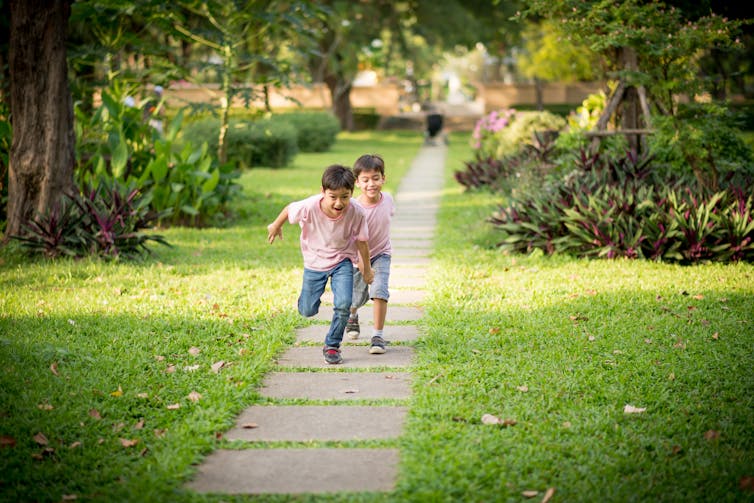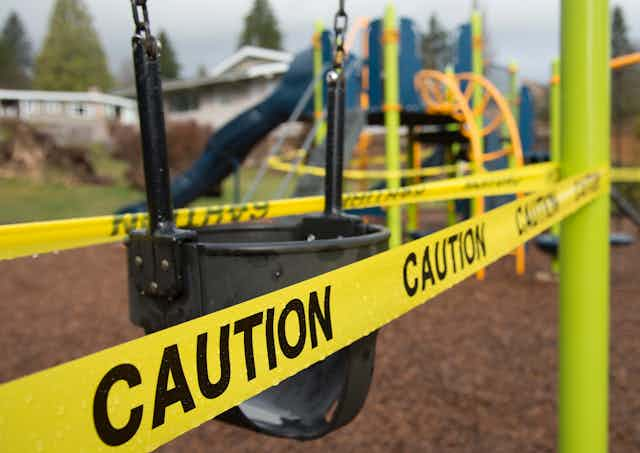“Mommy, the police are coming!” my nine-year-old calls to me from her scooter. We’re on the lakefront path near our home in Toronto and she’s anxious after seeing by-law enforcement officers patrolling the park.
We’ve also heard about the father in Oakville who was fined for rollerblading in an empty parking lot with his three children.
Many guidelines for outdoor activity in the pandemic don’t seem to consider children’s need and right to play. The City of Toronto’s guidelines on physical distancing speak of limiting trips outdoors.
Toronto has said in its COVID-19 changes to city services that “people can walk/run/bike” on the various routes through a park but there’s no mention of play.
So how can parents support a child’s need and right to play, when they don’t have a backyard or anywhere else to escape?
In my doctoral work at the University of Toronto, I study children’s outdoor play. I’m particularly interested in how adults support outdoor play to ensure children have access to high-quality play opportunities. I’ve learned that all adults, from public health officials to police officers to parents and neighbours, need to understand the importance of outdoor play to healthy child development in order to support it.
Access to play in a pandemic
While parents strongly influence whether their children go out to play, access to spaces and places to play matters. Some families have private backyards or cottages and some live in houses with wide boulevards and fewer cars, but many do not.
Although the key public health imperative in this crisis is to stay apart from others, official guidelines encourage us to stay home. The closing of all national parks, many provincial parks and conservation areas has reduced public access to green spaces. In Toronto, where we live, even High Park is currently closed as budding cherry blossoms tend to attract crowds.
When municipal playground equipment is also closed, children’s play naturally increases in other community spaces, including neighbourhood streets.
In our small townhouse complex, children and families play in the laneway and culs-de-sac. We have to be mindful of cars for safety. While many of our neighbours support children’s play, some complain it’s a noisy nuisance and do not welcome children or our basketball net in our community space.
Even under normal circumstances, all of these challenges of finding spaces to play are multiplied when high-rise apartment buildings and population-dense neighbourhoods suffer from a lack of urban planning for children’s play.
In a pandemic, when playgrounds and parks are closed, how on Earth are parents with varied access to the outdoors supposed to manage when there is nowhere for them to take their children to play outside?

Children don’t ‘exercise,’ they play
While adults quietly go out for a walk and to exercise, children energetically burst outside to play.
In outdoor play, children run, skip, climb, circle back and stop to explore. They build and destroy. They take risks and test their limits. Children pretend and make up their own games. They play traditional games like basketball. They also make some noise!
Children need play more than ever right now.
Like everyone else, children are under great stress during COVID-19. They are separated from school and friends, and they are trying to adapt as best they can. Tragically, some children are at increased risk for abuse when stuck inside with stressed caregivers. Physical activity researchers have expressed concern about the potential demise in healthy movement behaviours during the pandemic, particularly for vulnerable families in high-density housing with reduced access to the outdoors.
Making sure all children can play outdoors is one of the best ways to help kids because outdoor play has multiple benefits. It supports mental health. It keeps kids active and healthy, which in turn supports learning and development.
Children think creatively and solve problems as they play. They learn to get along with others and manage their behaviour.
Canadian guidelines recommend children spend several hours a day in light physical activity that is most naturally acquired outdoors through play where there is room to move. And for once in our busy lives, children have more time to play!

A child’s right to play
The child’s right to play, as guaranteed by Article 31 of the UN Convention on the Rights of the Child, is compatible with physical distancing principles when we recognize outdoor play as the natural, desirable behaviour of children.
Children should be encouraged to play outdoors safely, not stuck inside or channelled into “exercising” as the only manner to use a park. The risk of virus transmission via contact with shared surfaces can be eliminated by asking families to use their own play materials and equipment.
Amid uncertainty about children as spreaders of the coronavirus, decision makers might consider children’s need to play with other children and assess the risks versus the benefits of limiting social play beyond individual households. Closing streets and enabling the use of vast empty parking lots would provide increased space to play where green space is scarce.
Although greater attention to child-friendly urban planning is required to truly address equitable access to outdoor play, more can be done now. If we stop to consider children’s particular needs, adults can find ways to support outdoor play through more inclusive public health policy and its implementation.
As we navigate and move beyond this crisis, outdoor play can be a powerful intervention for children’s present and future well-being — as long as access to the outdoors doesn’t hinge on a family’s backyard status.

